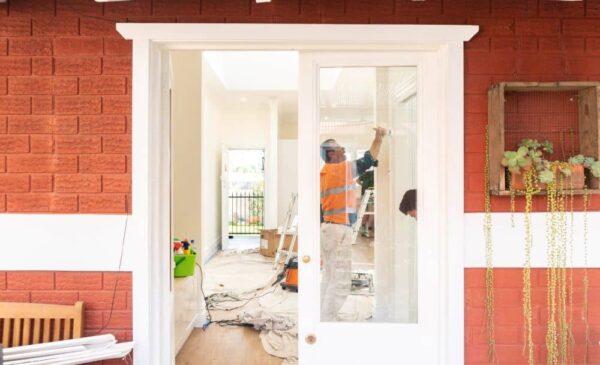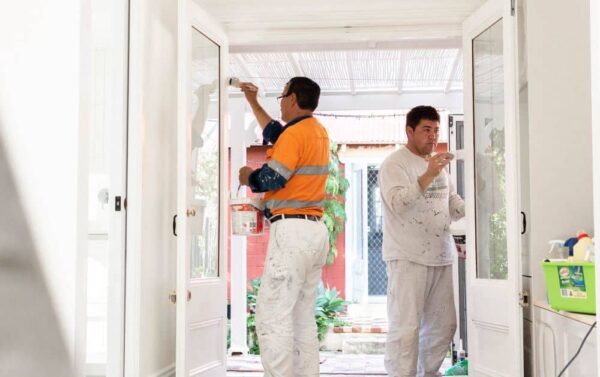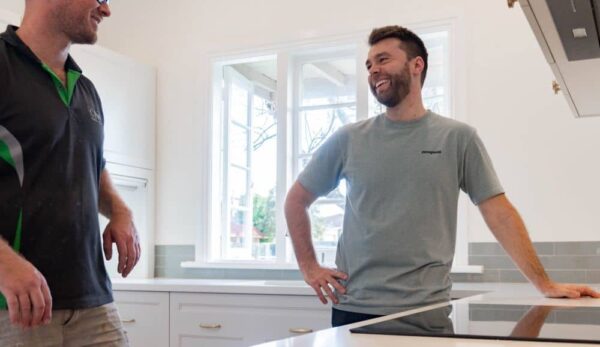Renovating your home can be daunting, but it’s also fun, especially when you have a plan. Most plans, however, involve so many details that can quickly overwhelm you. What you need is a set of steps and tips that you can easily follow.
That’s exactly what this blog post aims for.
Use this guide to renovate your home with desirable results.
Step 1: Plan Before You Begin
A detailed home renovation plan is everything you need to steer the project in the right direction. That’s why it should always be the first step every homeowner should take. Unfortunately, its importance is not highlighted enough. For this reason, many renovations end up unsuccessful, requiring additional efforts and expenses.
Every renovation needs a plan that states the goal, design plan or inspiration and outlines all the tasks that should be completed.
The project plan typically has:
- Sketches or a detailed blueprint of the project goals
- A list of all the necessities (and wishes)
- DIY and professional steps
This is also the stage of the project where you should already know about local zoning laws and permits. Ensure that you are legally allowed to do the remodel and get permits. Many renovations do not need authorisation, so you can skip this part of the project. However, garage conversions, adding a new room that will change the structure of your home, or modifying the use of a particular space, may require a permit.
When should you apply for permits? It all depends on the scale of the project. It is recommended that you wait until you already have your renovation team and a project timeline. However, your plan should already be in the works six to 12 months before your project begins. That gives you ample time for adjustments and modifications.

Step 2: Set a Budget
Having a plan gives you an idea about what you would like to achieve and how to achieve it. You will also get a bird’s eye view of what you will most likely spend. Determining your budget is essential as it allows you to calculate the costs for building materials, permits, labour costs, décor, and other finishing touches.
Here’s a smart way to build your budget:
- Figure out how much you can and are willing to spend before finalising.
- Request estimates from as many builders and other similar professionals as you can.
- Get the average price of all the materials you will use for the project.
Important: Make sure that you set aside 10% AT THE VERY LEAST of your budget, which you can keep for unexpected expenses.
In the unfortunate event that your cost estimates do not fit your budget, don’t fret. Some parts of the renovation project may be eliminated, usually those of lower priority. Doing so will help lower the final cost.
Start your budget planning three to six months before renovation.
Step 3: Hire People
You may want to reduce the overall cost of the project, but this is not where you should do it. Don’t select contractors because they offer cheaper services.
Make sure that you consider the following, so you don’t regret your decision in the end:
- The workers’ years of experience
- Contracting licence
- Insurance certifications
- References
- Payment schedule
You may hire more than one contractor for a job. In this case, you should determine who will be in charge of the project even before it begins, which will help avoid any confusion that may arise.
Suppose you plan to complete the renovation without hiring professionals. In that case, you should still have the experience and knowledge to do the job required. It will help lower your expenses but be sure to ask for help from your friends and family, especially regarding things you are unsure of.
Hiring people should be done about two to three months before the renovation.

Step 4: Create a Timeline
So, your budget and team are now ready. It’s time to build a timeline that includes your desired start and end dates. This is crucial in ensuring you accomplish your plan. You can also determine when you want to have the renovation completed and then work from there to see when you should begin.
Discuss with your contractors, who can help you determine the potential span of the project. This phase is also where you should ask which steps of the renovation should be completed first and an estimate of their duration. Some parts of the remodel may run concurrently, so enquire about these activities, as well.
Your timeline should also consist of:
- When to clean out the area
- Shipping and delivery of the required materials
- Holidays or days off that the contractors may likely take
Have a calendar ready to mark out the parts of the project mentioned. It’s an excellent way to figure out the completion date. Even then, be sure to have some wiggle room if ever unexpected events arise. Don’t hesitate to consult with your contractors to get a realistic timeline that lets you stay within your budget.
You should already have an established timeline within two to three months before you begin the renovation project.
Step 5: Time to Pack Up Your Stuff
You are almost done planning for your home renovation. The next phase is to prep the space. If you live with other people in the house, they should know about the upcoming renovation. From here, you can create a plan that’s useful in avoiding the use of the room that’s about to be remodelled.
Most renovations do not require moving out of the house. But this decision will depend on the extent of the work being done. For example, if you have a major renovation in the master bedroom, you can make new sleeping arrangements in another part of the house. If it is your kitchen, you can build a temporary area where you can cook and eat.
You can get creative with your options when moving certain activities to other spots in your home. However, if you plan to renovate your entire place, you will most likely have to evacuate and stay in another property for the time being.
Regardless of the size of the renovation, you will probably have to move some of your appliances, furniture, and other items out of the room that will be under construction.
Make sure that you accomplish this task about two to three months before the renovation process. If you have to move out or remove some stuff out of the house, we recommend packing up one to two weeks before renovating.

Step 6: Store Your Belongings On-site
Yes, you can cover some of your items with a tarp or put them in a box. However, some should be removed from your home. You surely agree that expensive and fragile objects should be protected. In that case, you need to store them somewhere else. Whilst you can ask for help from your friends or family members, it’s not always a good option. This is where you would want to rent a storage unit.
Renting storage during a home renovation is beneficial for several reasons:
- It’s cost-effective – You can store everything in one place. Perhaps you can keep certain items in your parent’s or friend’s house. However, they may not have enough space for other stuff, especially bigger ones like sofas, tables, and chairs. You can take advantage of a storage unit because it has adequate room for all the things you should remove from your home during construction.
- It’s safe – Placing your furniture in another person’s home may save you money. However, you cannot keep an eye on your belongings. If there are kids in that house, they could knock your valuables over and damage them. When you rent an onsite storage unit, you do not have to worry about these issues because your items will never be exposed to damage, whether caused by humans or environmental factors.
- It’s for de-cluttering – One of the renovation goals is to have a bigger space with as little clutter as possible. A storage unit will allow you to keep your things organised. You can easily declutter your home and even help you figure out what to keep and what to get rid of.
Renting a storage unit is so much better than covering items with a tarp. Renovations can be highly stressful. The last thing you need is to worry about your expensive or breakable possessions that may be in your parents’ or in-laws’ home. Instead of depending on other people to look out for your furniture or other belongings, you can rest assured knowing they will be kept safe away from harm in a storage unit. Even in bad weather, you can trust that the items are in a safe place.
Additional Tips
Your job is not done. We encourage you to check and recheck your list of things to do before the renovation. Here are some important tasks that many people often disregard, which then lead to less than attractive remodelling results:
Ask Contractors plenty of questions
Don’t be afraid to ask for more information from the contractors who are the actual pros of the activity you’re dealing with. Start by inquiring them for their professional advice or opinion regarding the materials you wish to use, a good budget, and a reasonable timeline or schedule.
It’s also a good idea to get their opinion about other contractors you plan to hire or have already hired. Be sure to get the views of both sides, however.
That being said, it is wise to stick to your plans. Some of the contractors’ recommendations may inspire and help you find smarter methods. However, if certain ideas are more expensive and will take you longer despite their professional opinion, you have the option to disregard their advice. Unless there is a good reason to change your existing plans, you should use their expertise as a means to validate your existing choices and to avoid making mistakes.

Prepare and have solutions ready
Even the most detailed of all plans can still go awry. It’s not the time to sulk. If you go beyond your budget, run out of materials, or some workers quit, you should always have a backup plan.
You should have extra finances, as mentioned above, to keep the project going, should things go wrong. Allot a few more days in your timeline to help prevent stress. Whilst it is acceptable to tap into your extra funds, overspending on renovation should never be an option.
Focus on structural projects First
Your goal in a home renovation is to complete structural work first. We’re talking about foundation, roofing, electrical systems, or other similar improvements. They should be prioritised over other tasks, especially cosmetic changes, such as painting a wall.
For example, you wish to renovate your kitchen. However, you have a leaky roof. You want to fix your roof first since water can destroy your new kitchen if you do not take care of it.

Plan for waste removal
Renovation means that your home will be piling on concrete and other building materials. You do not want them to be in your driveway, which could keep you from driving in and out of your garage. Before the project starts, have waste removal services included in your budget. You may also want to discuss with your contractor whether you are responsible for the debris removal or the team can take care of it for you.
We hope that this guide helps you finish your home improvement project with less hassle. Contact Spacebox for your on-site storage needs to keep your belongings safe and protected from harsh weather and environmental conditions.
